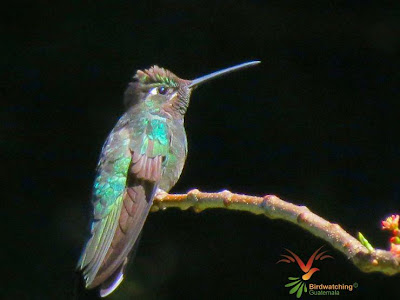Guatemala Birding Tours:
The Magnificent Hummingbird (Eugenes fulgens)
www.birdwatchingguatemala.com is a registered trademark of Martsam Tour & Travel Copyright® 2013 www.birdwatchingguatemala.com - www.martsam.com
The Magnificent Hummingbird (Eugenes fulgens)
The Magnificent Hummingbird (Eugenes fulgens) is a large hummingbird that breeds in
mountains from the southwestern United States to western Panama. It is the only
member of the genus Eugenes, although the northern, nominate subspecies E. f.
fulgens has on occasion been separated from the larger, southern race of Costa
Rica and Panama, E. f. spectabilis, as Rivoli's Hummingbird.
This
bird inhabits the edges and clearings of montane oak forests from about 2000
meters to the timberline. This large species can range from 11–14 cm (4.3–5.5
in) in length and can weigh from 6 to 10 g (0.21 to 0.35 oz), with males being
typically a little larger than females. Of the hummingbirds found in the United
States, the Magnificent Hummingbird is one of the two largest species being
rivaled only by the Blue-throated Hummingbird. In the southern reaches of its
range, the Magnificent may co-exist with other hummingbird species of
comparable or slightly larger size. The black bill is long and straight to
slightly curve. Both sexes look very dark unless the sun catches the
iridescence of the plumage and the brilliant colors flash in the sunlight.
The
adult male is green-bronze dorsally, becoming more bronzed on the black-tipped
tail. The crown is violet, the throat gorget bright blue-green, and the rest of
the head black apart from a white spot behind the eye. The chest is
green-bronze and the belly greyish.
The
female Magnificent Hummingbird is bronze-green dorsally and has a dull grey
ventral coloring. There is a white stripe behind her eye. Immature birds are
like the female, but darker and browner.
The
female is entirely responsible for nest building and incubation. She lays two
white eggs in her bulky cup nest about 3 meters up near the tip of a descending
branch stem. Incubation takes 15–19 days, and fledging another 20–26.
The
food of this species is nectar, taken from a variety of flowers, and some small
insects. Magnificent Hummingbird males perch conspicuously and defend their
feeding territories aggressively. The call of this species is a guttural drrrk.
(From Wikipedia, the free encyclopedia)
www.birdwatchingguatemala.com is a registered trademark of Martsam Tour & Travel Copyright® 2013 www.birdwatchingguatemala.com - www.martsam.com



Comments